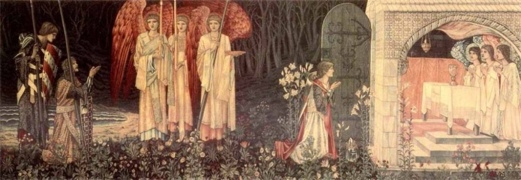Part 2 of my previous repost:
So, anyway…
Did you know that one of Christopher Columbus’s motivations behind his expeditions was a desire to help fulfill conditions so that the Second Coming could take place? Me either. This tied into the millennial twitchiness that surrounded the approach of the year 7000 (7000 Anno Mundi that is; this calendar counted years from the Creation of the world), twitchiness that influenced a bunch of mystical works throughout Europe, which in turn influenced Christopher Columbus. The unnerving thing about this is that 7000 AM is the equivalant of 1492 AD, which is when Columbus discovered America. He saw the discovery of the New World as being a culmination of God’s plan, and although it didn’t lead to the end of the world, I guess 1492 could be seen as apocalyptic for the Native Americans, the Aztecs, and everyone else who got trampled in the rush to create a new world in the New World.
Of course, Europe had just experienced the development of the printing press, and was about to embark on the Reformation, which meant the ability to interpret the Bible was suddenly available to the masses. You can see this in England in the mid-1600’s; the Civil War shook the foundation of society, and maybe it’s no coincidence that the execution of Charles I in 1649 coincided with the development of a bunch of millennial and apocalyptic groups – the Levellers, the Diggers, the Ranters, the Quakers, the Muggletonians, the Fifth Monarchy Men. And because of the whole ‘666’ thing, 1666 was expected to see the End of the World. I guess if you were in the middle of the Great Plague and then the Great Fire of London, it might have seemed like it was.
This all burnt itself out – after all, how many times can the world not end and a complete overhaul of society fail to come about? The apocalyptic vibe jumped across the Atlantic and really kicked off in the mid-19th Centrury. The main example of this is the story of the Millerites. William Miller figured that the Second Coming was due to happen on October 22 1844. An estimated 100,000 people eagerly awaited the moment when Jesus came back to Earth. It didn’t happen.
This become known as the Great Disappointment which, frankly, is the greatest example of under-statement in history.
Twitchiness wasn’t just seen in the big religious movements. I guess the end of A world, the mutation of a society, the moment at which things stop being how they used to be can be seen behind some of the moral panics that keep cropping up every so often. Hidden enemies threatening to undo civilisation are seen behind every shadow. Witches stalked the fields of Europe, and of New England, and some figured they had to be stopped. It’d be nice to write that off as something that only happened in history, but look at fifties America – the McCarthyite anti-Communist witch-hunts kicked off in 1950, ruined the lives of a lot of people, then faltered in 1954. This just happened to be the year in which Dr. Frederic Wertham published The Seduction of the Innocent, a tirade against comic books that saw homosexual propaganda in the relationship between Batman and Robin, and corrupting, hidden images hidden within the art. The brief flap surrounding this lead into the age of Rock and Roll, when the bottom half of Elvis was banned from TV.
So what’s the point of thinking about all this, about flicking through a bunch of books and reading a whole lot more Wikipedia entries? Well, maybe the idea of the END is hardwired into us, just like we seem to be pre-programmed to tell certain kinds of stories. This theory is a double-edged sword; on the one hand it can get out of hand, exploding into fanaticism and bloodshed and people achieving infamy over a pile of corpses. Today it threatens to explode into a modern crusade, fought with nukes and satellites, passenger planes and dirty bombs. Be honest, seeing those planes fly into the WTC…There was something apocalyptic about that.
On the other hand, the idea of the End – if not of the world, then of the live upon it, if not of that then of our way of life – forces us to confront some home truths; truths about the way we treat our environment and the effect we have on the species that surround us, truths about the way we treat our neighbours and the ‘other’, truths about the way we abuse our beliefs to justify the darker angels of human nature.
So if the End is due to come from environmental collapse, maybe we should look at the way in which we contribute to pollution or climate change. If the End is going to be the result of a clash of ideologies, maybe we should be more interested in building bridges than stockpiling canned goods. And if the End is going to come from the hand of God, then maybe we should consider the spiritual side of our nature, and in all things be as prepared as we can be when the End finally comes.
But for now, the End hasn’t come. So turn round, hug your loved ones and make the most of life. It’s the only one you get.

